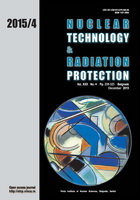
NEUTRON ACTIVATION DETERMINATION OF GOLD IN TECHNOGENIC RAW MATERIALS WITH DIFFERENT MINERAL COMPOSITION

Vol.
XXX, No. 4, Pp. 239-323
December 2015
UDC 621.039+614.876:504.06
ISSN 1451-3994
Pages: 273-279
Authors: Aleksandr A. Yudakov, Sergey I. Ivannikov, Veniamin V. Zheleznov, Andrei V. Taskin, and Oksana N. Tsybulskaya
Abstract
The methods used to determine the gold content in the technogenic objects of gold mining were analyzed regarding their non-homogeneity and complexity of chemical and mineral compositions.A possible application of the neutron activation analysis with the use of the californium source of neutrons for determining the content of fine-grained and extra-fine-grained gold in the technogenic objects, including the bottom-ash waste of energy providers, is considered. It was demonstrated that the chemical composition of the sample affects the neuron flux distribution in the sample, which can essentially distort the results of the neutron activation analysis. In order to eliminate possible systematic errors investigations of the effect of the sample mineral composition on the results of the gold determination using the neutron activation analysis were carried out. Namely, a large mass of rock (3-5 kg) was loaded into an activation zone using four matrix types such as silicate, carbon-containing, iron-containing, and titanium magnetite. It was shown that there wereno significant difference between the dispersal of the fluxes of thermal and resonance neutrons emitted from 252Cf during activation of the gold-containing technogenic samples with different mineral compositions.
Key words: neutron activation analysis, fine-grained gold, technogenic object, californium, activation zone, thermal neutron flux
FULL PAPER IN PDF FORMAT (7.45 MB)